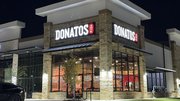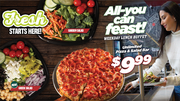Article
Foodservice Packaging Institute: Restaurateurs struggle for options to single-use packaging
There may never have been a more contentious time for restaurant brands when it comes to their dependence on single-use packaging. Read on for news about what the Virginia-based Foodservice Packaging Institute found about the issue in its annual report.

February 6, 2019 by S.A. Whitehead — Food Editor, Net World Media Group
There may never have been a more contentious time for restaurant brands when it comes to their dependence on single-use packaging. Last year, stories swirling around a given brand's decision to use or not use plastic straws ranked among the top food news stories of the year by number of readers.
Still, pizza brands and other limited-service restaurant categories — many of whom depend dearly on inexpensive, sanitary packaging — continue to struggle to come up with solutions to the questions once answered by disposable pizza boxes, plastic cups, straws, utensils and any of the many other wraps and containers a typical brand must have to do business.
"Operators are in a tough spot because much of their business isn't possible without the use of single-use packaging items, while their customers show increased interest in the environmental impact of those items." FPI President Lynn Dyer
At the eye of this pizza-stained cardboard and plastic-strewn cyclone is the Foodservice Packaging Institute (FPI) in Falls Church, Virginia, where member companies are struggling to get with the recyclable, compostable, reusable wave, while still staying in business themselves. In fact, FPI told this website that packaging concerns showed up as one of the biggest issues in their annual Trends Report.
As FPI President Lynn Dyer put it in an interview with Pizza Marketplace, all the associated food packaging turmoil is "leading people to question the purpose of single-use." Now consumers and brand leaders alike are looking for answers to two primary questions that ask:
- Can limited service brands make it without single-use packaging?
- Can single-use packaging be replaced with multi-use items?
Dyer said these difficult questions prompted FPI to forecast continued hot and heavy debate on this front as brands search to learn the true environmental impact of single-use food packaging, while increasingly looking into the use of renewable materials or recycled content for food packaging, with even more emphasis on recyclability and compostability.
"Operators are in a tough spot because much of their business isn't possible without the use of single-use packaging items, while their customers show increased interest in the environmental impact of those items," Dyer said.
After FPI's Trends Report was completed, Dyer sat down to give us an overview of some of the current packaging options under consideration across the restaurant industry, as well as some of the food packaging trends taking place in-market at the moment,. We started our Q-and-A with her on the subject of current sustainable packaging options in-market.
Q: What are the options currently in food service package for recyclable products or at least those that offer some sustainable benefits?
A: Sustainable options can include an emphasis on what the products are made from, like renewable materials or use of recycled content. Other sustainable options emphasize what the consumer can do with the packaging once it's been used.
Recycling or composting is preferred over sending these valuable materials to the landfill. In a perfect world, packaging balances both of these options.
Q: Is plastic still a dirty word?
A: Plastic does seem to be the word that catches the most flak for being single-use — with the drinking straw becoming the "poster child" for this movement. But that's really too bad, as there are many benefits to plastics. All materials have an environmental footprint, and it's up to foodservice operators to balance their needs and the environmental attributes of the packaging they purchase.
Q: What's on the horizon that might offer brands some real benefits and new options in the future?
A: For many years, the industry offered foodservice packaging made from paper, plastics and aluminum. We've already seen new materials enter the marketplace, and we'll continue to see material innovations that provide a smaller environmental footprint.
The tricky part is materials that are environmentally friendly, but ... also on par in terms of price and performance — the top two criteria operators use when selecting packaging.
"Delivery offerings have elevated the importance of foodservice packaging for a few reasons. First, and most obviously, it keeps the hot foods hot and cold foods cold as it's delivered (even greater distances) from Point A to Point B." Lynn Dyer
Q: How much clamor is this issue creating with diners?
A: Overall, diners are increasingly asking questions about the foods and beverages they eat and drink. Think about the growing interest in organic, gluten-free, "clean" ingredients, etcetera. It's a short step to then consider how those foods and beverages are packaged.
While it's not across all market segments, regions or demographics, there is enough interest to make activist groups, legislators and others take notice and want to take action. We hear this from the supply chain throughout the annual Trends (Report) Survey, and from other stakeholders within the industry and beyond.
Q: How has the growing importance of delivery and off-site QSR consumption affected food packaging demand?
A: As the demand for food and beverages on-the-go continues to increase, heat and cold retention becomes even more important. People are grabbing their food and beverages while they're out and about, and may not be able to eat or drink something right away.
Delivery offerings have elevated the importance of foodservice packaging for a few reasons. First, and most obviously, it keeps the hot foods hot and cold foods cold as it's delivered (even greater distances) from Point A to Point B.
Second, the package protects the food inside once in transport, leading to greater use of tamper-evident packs.
Third, it creates the only opportunity to promote a foodservice brand when the customer doesn't interact with the brand itself, using any number of third-party apps to order his or her meal.
Q: What are the trends in packaging appearance currently and is that still as big a component in packaging choice as it has been?
A:Food service operators are recognizing that the packaging that they use can be a "walking billboard" for their brands, and packaging provides a great engagement and promotional opportunity. Brands have a story to share with their customers, and it can be done through packaging.
We'll continue to see use of better graphics, embossing, different shapes, etcetera, so brands can differentiate themselves.
Editor's note: In April, Dyer will be a guest on the QSRweb podcast to discuss some of the innovative options packaging companies are creating to meet demands for more environmentally friendly food service industry options.
Photo: iStock
About S.A. Whitehead
Pizza Marketplace and QSRweb editor Shelly Whitehead is a former newspaper and TV reporter with an affinity for telling stories about the people and innovative thinking behind great brands.










